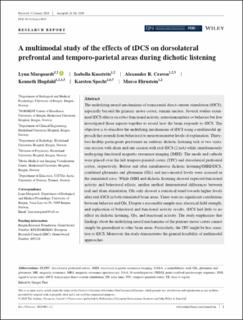| dc.contributor.author | Marquardt, Lynn Anne | |
| dc.contributor.author | Kusztrits, Isabella | |
| dc.contributor.author | Craven, Alexander R. | |
| dc.contributor.author | Hugdahl, Kenneth | |
| dc.contributor.author | Specht, Karsten | |
| dc.contributor.author | Hirnstein, Marco | |
| dc.date.accessioned | 2021-05-21T14:48:00Z | |
| dc.date.available | 2021-05-21T14:48:00Z | |
| dc.date.created | 2020-11-30T12:55:04Z | |
| dc.date.issued | 2020 | |
| dc.Published | European Journal of Neuroscience. 2020, 1-11. | |
| dc.identifier.issn | 0953-816X | |
| dc.identifier.uri | https://hdl.handle.net/11250/2756086 | |
| dc.description.abstract | The underlying neural mechanisms of transcranial direct current stimulation (tDCS), especially beyond the primary motor cortex, remain unclear. Several studies examined tDCS effects on either functional activity, neurotransmitters or behavior but few investigated those aspects together to reveal how the brain responds to tDCS. The objective is to elucidate the underlying mechanisms of tDCS using a multimodal approach that extends from behavioral to neurotransmitter levels of explanation. Thirty-two healthy participants performed an auditory dichotic listening task at two visits, one session with sham and one session with real tDCS (2 mA) while simultaneously undergoing functional magnetic resonance imaging (fMRI). The anode and cathode were placed over the left temporo-parietal cortex (TPC) and dorsolateral prefrontal cortex, respectively. Before and after simultaneous dichotic listening/fMRI/tDCS, combined glutamate and glutamine (Glx) and myo-inositol levels were assessed in the stimulated areas. While fMRI and dichotic listening showed expected functional activity and behavioral effects, neither method demonstrated differences between real and sham stimulation. Glx only showed a statistical trend towards higher levels after real tDCS in both stimulated brain areas. There were no significant correlations between behavior and Glx. Despite a reasonable sample size, electrical field strength, and replication of behavioral and functional activity results, tDCS had little to no effect on dichotic listening, Glx, and functional activity. The study emphasizes that findings about the underlying neural mechanisms of the primary motor cortex cannot simply be generalized to other brain areas. Particularly, the TPC might be less sensitive to tDCS. Moreover, the study demonstrates the general feasibility of multimodal approaches. | en_US |
| dc.language.iso | eng | en_US |
| dc.publisher | Wiley | en_US |
| dc.rights | Navngivelse-Ikkekommersiell 4.0 Internasjonal | * |
| dc.rights.uri | http://creativecommons.org/licenses/by-nc/4.0/deed.no | * |
| dc.title | A multimodal study of the effects of tDCS on dorsolateral prefrontal and temporo-parietal areas during dichotic listening | en_US |
| dc.type | Journal article | en_US |
| dc.type | Peer reviewed | en_US |
| dc.description.version | publishedVersion | en_US |
| dc.rights.holder | Copyright 2020 The Authors. | en_US |
| cristin.ispublished | true | |
| cristin.fulltext | original | |
| cristin.qualitycode | 1 | |
| dc.identifier.doi | 10.1111/ejn.14932 | |
| dc.identifier.cristin | 1854105 | |
| dc.source.journal | European Journal of Neuroscience | en_US |
| dc.source.pagenumber | 449-459 | en_US |
| dc.identifier.citation | European Journal of Neuroscience. 2021, 53 (2), 449-459 | en_US |
| dc.source.volume | 53 | en_US |
| dc.source.issue | 2 | en_US |

